






|
Full Cat PressI'm only using that title for this entry because it came to me tonight while driving up 101 and I thought it would be a good name for a journal. Or a rock band. Or something. This entry is really going to be a bunch of comic book reviews, though, so John can stop reading now.
 I have a few specific essays on comic books I want to write (specifically about Grant Morrison, and The Authority), but this is a round-up of comic books from the last few weeks. So, (as the saying goes in baseball) from worst to first:
Had I come to this story with high expectations I would have been bitterly disappointed, since it's absolutely awful. (Fortunately, my expectations were modest, since I wasn't a big fan of the original Dark Knight, mainly because I feel Miller's grasp of Bruce Wayne's psychology is way off-target. In other words, it's very much at odds with my perception of Batman.) DK2 is, essentially, Sin City meets Kingdom Come. Like KC, we have a future world where the heroes have mostly retired, and which has become a dystopia. A hero comes out of retirement to reassemble some of the heroes and change the world. Miller even brings out some notions which have already been done to death elsewhere, such as a Superman/Wonder Woman relationship (KC), and the nature of Captain Marvel's dual identity (Miracleman). Miller's writing style has become more hard-boiled during his years doing Sin City (which is enjoyable mostly because it tackles some edgy issues in a darkly humorous nature), and his dialogue in particular doesn't transplant at all well to these characters. "Yes. He can. He's our only hope. The bastard, he's's our only hope," just doesn't sound like a Superman line. Nor does Batman's taunting of a psychopathic killer at the end of the story. (Said killer, by the way, plays a very minor role in the story and seems entirely gratuitous. Why did Miller bother?) The story itself is a fairly trite "power to the people" yarn, messily told and with little clear resolution. It seems like Miller actually had little to say, and the book focuses so much on other heroes that it hardly feels like a Batman story at all. It feels like he just wanted to play with the other characters (and - I say cynically - draw a large paycheck). If you've already picked up this one, then you have my condolences. If not, then give it a wide berth.
For instance, take a look at these shots of Peter Parker's head. While I agree it meets some minimum anatomical standard, the funny-shaped nose, the lifeless eyes, the blank expression in the mouth. Is this a man, or some sort of reanimated corpse? And this sort of expression is common in Romita's art in the series. His figures rarely show a range of emotion; a sly smile, a vaguely pained expression, a menacing leer, that's about all we really get. Well, and bystanders showing fear at the exploits of the current villain.
Anyway, between the bad art and waiting for the story to Go Somewhere, I'm rapidly running out of patience with ASM.
Moore has a simple but elegant and dynamic drawing style, and a deft hand at characterization and dialogue. Though not as outright hilarious as early issues of Jeff Smith's Bone, the characters feel fuller and warmer, and the story is often extremely funny. Check this one out; you won't regret it.
The first issue mostly occurs on Mars, where Moore tries to weave together a variety of fictional representations of the planet. (You can get a scorecard for the series at Jess Nevins' Comic Book Annotations site.) Most notably, we see a coalition of forces led by John Carter fighting off a group of alien invaders, who depart for Earth near the end. Yes, the aliens are in tripods, and are about to enact H.G. Wells' The War of the Worlds, only with our heroes caught in the middle. O'Neill's astoundingly detailed art is often breathtaking, and though the story is a bit thin, it's clearly just prologue for the issues which follow. The first volume was perhaps the best work Moore has done since Watchmen (or maybe From Hell), and this one has the potential to be even better. The lengthy textual "tour" of the LoEG world at the end is also quite entertaining. (By the way, in case you haven't heard, LoEG is being turned into a movie, featuring Sean Connery. I doubt it will be entirely faithful to the series, but I'm looking forward to it anyway.)
|
||
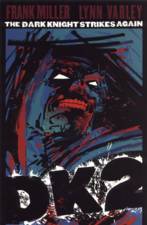 The Dark Knight Strikes Again (DC) just concluded with its third issue. The eagerly-awaited sequel to The Dark Knight Returns - again by original creators Frank Miller and Lynn Varley - takes place several years after the end of the first series, when Batman comes out of the depths of hiding to reassemble the Justice League to fight against the corrupt officials who are running the country (centered, not surprisingly, around Lex Luthor). Carrie Kelly - this time dressed as Catwoman rather than Robin - is again his loyal sidekick. Along the way we meet The Flash, The Atom, Superman, Wonder Woman, Captain Marvel, The Question, Green Arrow, Plastic Man, and a few surprises.
The Dark Knight Strikes Again (DC) just concluded with its third issue. The eagerly-awaited sequel to The Dark Knight Returns - again by original creators Frank Miller and Lynn Varley - takes place several years after the end of the first series, when Batman comes out of the depths of hiding to reassemble the Justice League to fight against the corrupt officials who are running the country (centered, not surprisingly, around Lex Luthor). Carrie Kelly - this time dressed as Catwoman rather than Robin - is again his loyal sidekick. Along the way we meet The Flash, The Atom, Superman, Wonder Woman, Captain Marvel, The Question, Green Arrow, Plastic Man, and a few surprises. Amazing Spider-Man #43 (Marvel) continues the critically-acclaimed series by writer J. Michael Straczynski and artist John Romita Jr. I'm not nearly as high on it as some are, though. Part of this is because I feel like Straczynski has fumbled the ball from his great first story and has gone from turning the wall-crawler's world upside-down to telling fairly mundane adventure yarns about him, interchangeable with any other such yarns.
Amazing Spider-Man #43 (Marvel) continues the critically-acclaimed series by writer J. Michael Straczynski and artist John Romita Jr. I'm not nearly as high on it as some are, though. Part of this is because I feel like Straczynski has fumbled the ball from his great first story and has gone from turning the wall-crawler's world upside-down to telling fairly mundane adventure yarns about him, interchangeable with any other such yarns.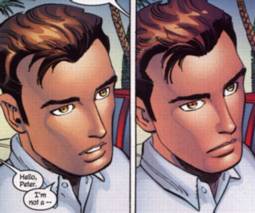 The big problem, though, is that I can't stand Romita's artwork. Since his halcyon days doing solid pencils for Michelinie and Layton's Iron Man stories circa 1980, his work has gotten ever-more-cartoony. His uninspired X-Men pencils, to be fair, suffered from unsympathetic inking by Dan Green. His Daredevil: The Man Without Fear work was decent enough, but it felt like he was striving very hard to bring a Miller/Mazzuccelli feel to the book. And now, I often have a hard time recognizing his Spider-Man characters as actual humans.
The big problem, though, is that I can't stand Romita's artwork. Since his halcyon days doing solid pencils for Michelinie and Layton's Iron Man stories circa 1980, his work has gotten ever-more-cartoony. His uninspired X-Men pencils, to be fair, suffered from unsympathetic inking by Dan Green. His Daredevil: The Man Without Fear work was decent enough, but it felt like he was striving very hard to bring a Miller/Mazzuccelli feel to the book. And now, I often have a hard time recognizing his Spider-Man characters as actual humans.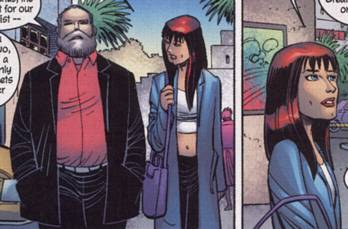 Then there's this shot of Mary-Jane Parker. Considering that she's supposed to be a stunningly beautiful woman, as well as one who's full of life and energy, her rail-thin appearance here seems to belong to somebody else. She looks positively emaciated. Sure, she's a model and they tend to be thin, but this is ridiculous.
Then there's this shot of Mary-Jane Parker. Considering that she's supposed to be a stunningly beautiful woman, as well as one who's full of life and energy, her rail-thin appearance here seems to belong to somebody else. She looks positively emaciated. Sure, she's a model and they tend to be thin, but this is ridiculous.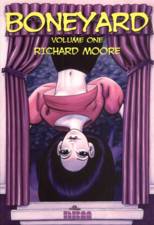 In a pleasanter vein, I was just turned on to Richard Moore's Boneyard (NBM) with the publication of the paperback collection of the first four issues. In it, Michael Paris is a young man who's just inherited a tract of land from his grandfather. But it turns out the tract is a cemetary which is home to a variety of supernatural creatures (including Abbey the vampire, shown on the cover). And the local town of course wants to buy the land from Michael and raze the place to get rid of the weird creatures (who include a demon, a skeleton, a werewolf, and several other oddities).
In a pleasanter vein, I was just turned on to Richard Moore's Boneyard (NBM) with the publication of the paperback collection of the first four issues. In it, Michael Paris is a young man who's just inherited a tract of land from his grandfather. But it turns out the tract is a cemetary which is home to a variety of supernatural creatures (including Abbey the vampire, shown on the cover). And the local town of course wants to buy the land from Michael and raze the place to get rid of the weird creatures (who include a demon, a skeleton, a werewolf, and several other oddities).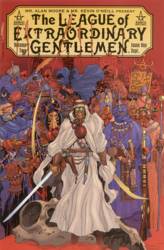 Having started this entry with a review of a completed long-awaited series, I'll close it with the first issue of another long-awaited series. The League of Extraordinary Gentlemen (America's Best Comics) began life as a 6-issue mini-series in which writer Alan Moore and artist Kevin O'Neill teams Mina Murray (nee Harker), Captain Nemo, Dr. Jeckyll & Mr. Hyde, The Invisible Man and Allan Quatermain as a crack team of 1898 investigators and troubleshooters for the British government. Now they're back in volume 2 of the series.
Having started this entry with a review of a completed long-awaited series, I'll close it with the first issue of another long-awaited series. The League of Extraordinary Gentlemen (America's Best Comics) began life as a 6-issue mini-series in which writer Alan Moore and artist Kevin O'Neill teams Mina Murray (nee Harker), Captain Nemo, Dr. Jeckyll & Mr. Hyde, The Invisible Man and Allan Quatermain as a crack team of 1898 investigators and troubleshooters for the British government. Now they're back in volume 2 of the series.